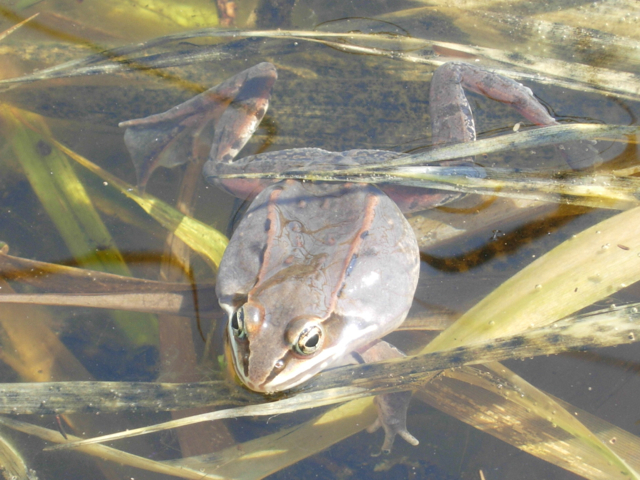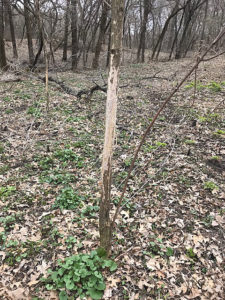Lisa Hake, a 2nd Grade teacher at Eisenhower Elementary, shares her video of a frog breeding pond (see below).
Lisa said the following about the experience: “This was an exciting happening to stumble upon on a walk. A few days before this area was still, the ground and water just barely thawed. Hearing the frog chorus was a wonderful sign that Spring is indeed on it’s way.”
In Lisa’s video, the wood frogs are making the “clucking” sound and the males are patrolling all around the pond. The spring peeper is also in the pond and is making a “peeping” sound like a baby chicken.
I hope you love frogs because the entire week is about them. Here is what’s hopping:
a. New weekly feature – Test Your Nature IQ
b. View the Amphibians and Reptiles Program.
c. Download the Amphibians and Reptiles of the Twin Cities chart
d. View Frogs, Frogs, Frogs and listen to their calls
e. Draw a frog with Artist Karen Anderson
f. Sing along with the Frog Song
Request! I am going to do a special posting on the Old Naturalist website called “The Best of Nature School.” Send me your observations, drawings, photos, poetry or stories of what you experienced. Tell me your age and school (if you are old, you are exempt from sharing your age and school).
Did you miss any of the first five weeks of Nature School? Click here to see links to the previous lessons.
Safety Alert: “Watch out for Ticks” Song
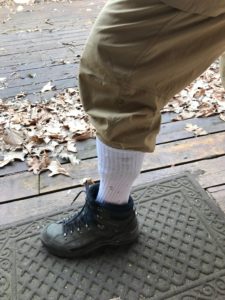 Ticks are out
Ticks are out
Got to watch out!
Walking paths – Yes
deer trails – No
You’ll find ticks
in tall grass
So
Pull your socks over your pant leg.
Look for ticks crawling up.
Tick check – Tick check
Several times.
When you’re home
Check again.
The idea for this song by Cindy Eyden
Thanks to Janine Pung for all the extra time she took editing this post. Thanks, also, to Karen Anderson, Mark Storck, Stephen Bolles, Lisa Hake and Cindy Eyden for contributing to Nature School this week.
1. New Weekly Feature – Test Your Nature IQ
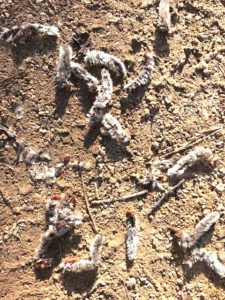
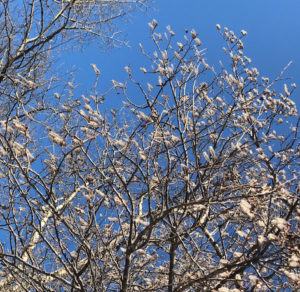 a. Have you noticed what looks like caterpillars on the ground?
a. Have you noticed what looks like caterpillars on the ground?
Those are the flowers of an aspen tree that have fallen on the ground. Aspen flowers are called catkins.
b. Have you heard this sound in forest? What animal made the sound and why?
That is the sound of a woodpecker “drumming.” It is announcing its nesting territory by “drumming” on a hollow tree.
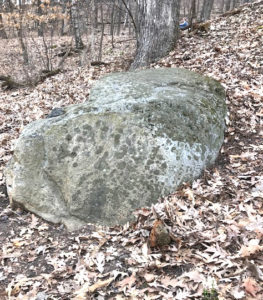 c. This rock is 5 feet long 3 feet high. It probably weighs more than 10 Tons and is about 1/2 mile from the nearest road. How did it happen to end up at that spot?
c. This rock is 5 feet long 3 feet high. It probably weighs more than 10 Tons and is about 1/2 mile from the nearest road. How did it happen to end up at that spot?
This rock is called a glacial erratic. It was deposited at that spot 15,000 years ago when the glacier melted. Can you think of a glacial erratic in your neighborhood?
d. What caused the bark of this young tree to be stripped off? Notice there is another one in the background too!
This is called a buck rub. A male deer marked its territory during the breeding season (last September) with its antlers.
1. Amphibians and Reptiles Program
We have a number of amphibians and reptiles in Minnesota and spring is a great time to see and hear them.
What to do:
a. In this activity, you will watch the slide program on amphibians and reptiles and then use the activity sheet to answer questions about each animal.
b. Click here to see the program on reptiles and amphibians.
c. Download the Midwestern Amphibians and Reptiles Activity.
This is a long program, so choose 10 animals to study and answer the questions using the following page: Click here for the PDF.
2. Amphibians and Reptiles of the Twin Cities
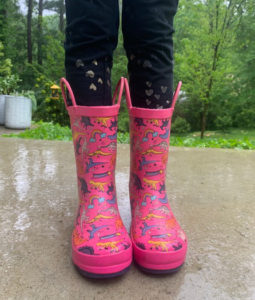 Do you have a pair of mud boots that you could wear to tromp around in a wetland this week? Try to get to a marsh or pond and look/listen for the chorus frogs and leopard frogs. See what you can find. Please don’t take any creatures home with you. They belong in the wetland.
Do you have a pair of mud boots that you could wear to tromp around in a wetland this week? Try to get to a marsh or pond and look/listen for the chorus frogs and leopard frogs. See what you can find. Please don’t take any creatures home with you. They belong in the wetland.
What to do:
a. Download and print the page (see link below)
b. Check off the amphibians and reptiles you have seen this spring and in the coming weeks.
c. Write about your wetland experience in your nature notebook.
To download and print the page below: click here. Put the page in your nature notebook.
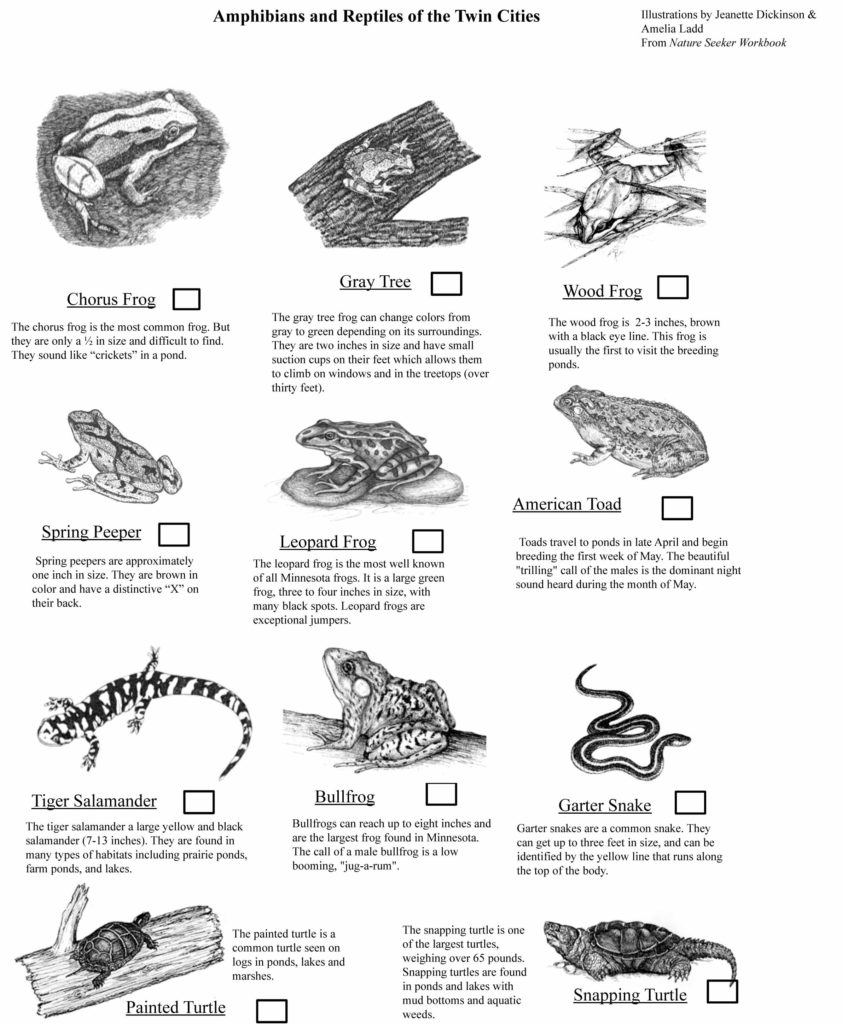
3. Frogs, Frogs, Frogs!
Listen to the calls of several of our local frogs and learn more about their lives.
What to do:
a. Click here to hear the frog calls.
b. Choose one frog and write a paragraph about it in your nature notebook.
4. How to Draw a Frog
Our artist in residence, Karen Anderson, continues our drawing lessons. This week she shows you how to draw a frog.
What to do:
a. Practice the basics of drawing a frog in your nature notebook by using Karen’s handout, “Draw a Frog.”
b. You may want to finish your sketch, filling in the details, using one of Jeanette Dickinson’s illustrations ( see activity #2).
To download and print “Draw a Frog” (below): click here.
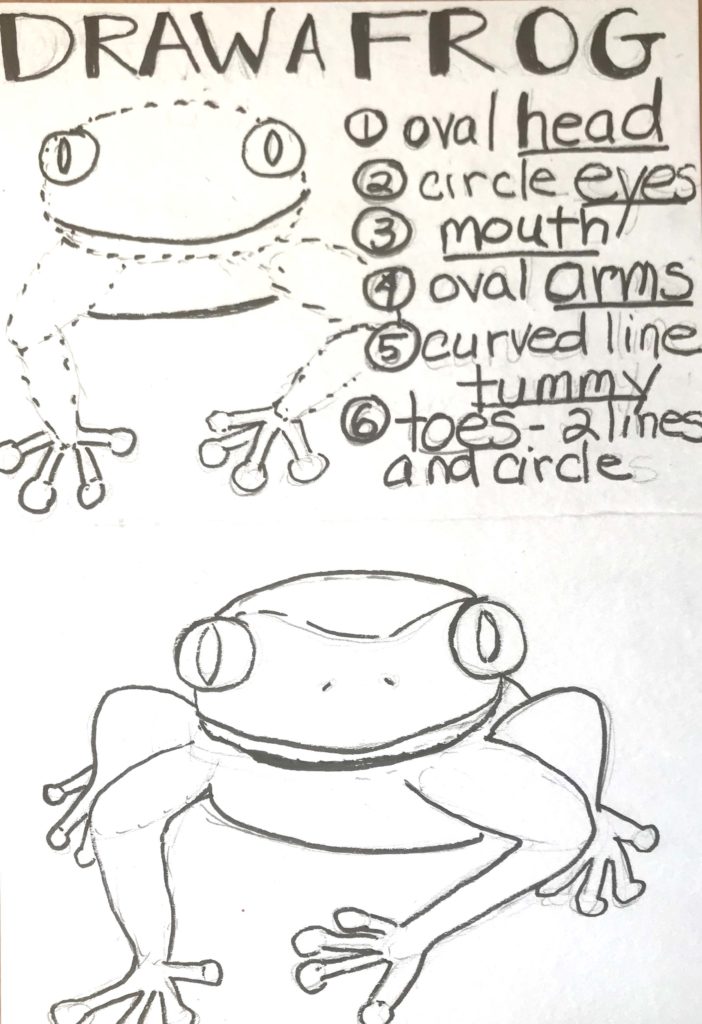
5. Frog Song
Lyrics and music by Lawrence Wade
What to do:
a. Click here to listen to the Frog Song
b.Sing along using the lyrics below:
Am Em
If I were a leopard frog, I’d have many spots.
Am Em
I’d be the king of the frog jumpers.
Am Em
I’d sing in the Spring: “Snore, snore, snore, snore”.
Am Em Am
In summer, I’d go ashore.
Chorus
C G
Frogs are the voice of the Spring wetlands
Am Em
Lay their eggs in the wetland’s marsh.
C G Am Em Am
Tadpoles grow into frogs ……metamorphosis.
Verse 2
Am Em
If I were a toad, I’d have red warts.
Am Em
I’d sing in the spring: “Trill, Trill, Trill”
Am Em
Spend the summer catching bugs.
Am Em Am
In winter hibernate.
Chorus
C G
Frogs are the voice of the Spring wetlands
Am Em
Lay their eggs in the wetland’s marsh.
C G Am Em Am
Tadpoles grow into frogs ……metamorphosis.
Verse 4
Am Em
If I were a Peeper, I’d be very small.
Am Em
You could hear me: “Peep, peep, peep, peep.”
Am Em
Peepers are magic, they come in the spring
Am Em Am
Then they disappear.
Chorus
C G
Frogs are the voice of the Spring wetlands
Am Em
Lay their eggs in the wetland’s marsh.
C G Am Em Am
Tadpoles grow into frogs, ……metamorphosis.

